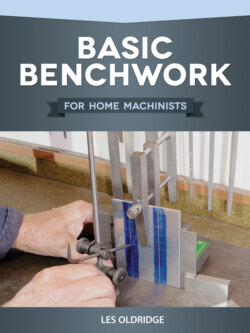Читать книгу Basic Benchwork for Home Machinists - Les Oldridge - Страница 6
На сайте Литреса книга снята с продажи.
Chapter 1 Introduction
ОглавлениеModern engineering workshops are equipped with machine tools capable of producing components to such accurate limits that hand fitting at the bench is no longer necessary. Mass production methods render the skills possessed by old-time fitters in danger of being forgotten forever. This is a pity, as in many situations, the ability to complete a job using only hand tools is a great asset. In any case, it is often quicker to bring a component to the correct dimensions using a hand method than it is to spend time setting up the job in a milling machine or shaper, even if one is available.
Machine tools owned by the model engineer are often limited to a lathe and, perhaps, a bench drilling machine, so he has to become skilled in the use of hand tools. The purpose of this book is to describe the basic skills he must acquire. It takes a great deal of practice to reach the standard required, and although disappointment may be experienced at first, with the slow progress made, the satisfaction when the job is concluded is well worth the work involved.
It must be emphasized that no textbook, however comprehensive, can take the place of actual experience at the bench. The best advice is to “have a go,” perhaps on a bit of scrap material, to gain the necessary skill and confidence before working on a valuable casting.
Throughout this book, special emphasis will be made on safe working. In industry, this is looked after by the Health and Safety at Work Executive, but in the amateur’s workshop, there is no legislation to ensure the worker has a safe working environment. It is up to the individual to look after himself and to help to this end the various hazards likely to be encountered will be outlined from time to time.
A simple first aid kit, and the knowledge of how to use it, is desirable. A fire extinguisher is also a good investment and the Fire Prevention Officer from the local fire department will be pleased to give free advice as to the best type to purchase to suit your particular needs.
If good work is to be produced, a sturdy, rigid bench, fitted with a good quality vise, is essential. Most model engineers are not wealthy and setting up a workshop is a costly business. I hope to suggest, where possible, ways of cutting costs without sacrificing quality. For example, good secondhand timber is often available at low prices; when buildings are being demolished, a tactful word with the site foreman may provide just what is needed to build a bench at low cost.
Fig. 1.1 Vise clamps bent up in aluminum, copper, or lead, dimensions to suit vise.
Legs made from at least 3 in. square timber and the top from 2 in. planks should be aimed at. The space between the legs can be used to house a useful cupboard.
The size of the vise will depend on the type of work to be undertaken, but it is better to have one a little larger than is thought to be necessary, to allow for “future expansion,” that is, for the bigger jobs which may come along later.
The height of the bench should be such that the top of the vise jaws are in line with the point of the user’s elbow. This makes filing accurately much easier, but more about that later.
The vise jaws are serrated to prevent the work slipping when roughing down. Clamps, sometimes called clams, to fit over the jaws are needed to prevent these serrations from damaging finished surfaces. They may be made of lead, copper, aluminum, or fiber or any other soft material (see Fig. 1.1).
Various special clamps can be made to hold round, or odd, shaped work securely in the vise. Fig. 1.2. shows an easily made and useful device for holding round bar or pipe. Holes of a size to suit the bars in common use are drilled, as shown, in a piece of mild steel 25mm × 12mm (½ in. × 1 in.) and of a length to accommodate the number of holes required. A saw cut is made through the center of all the holes, except the end one. A similar gadget for holding threaded material can be made in a like fashion, except that the holes are threaded before the gadget is split with the type of thread generally used. These two projects form a useful exercise after reading the chapters on hacksawing, drilling, and cutting screw threads!
Fig. 1.2 Vise clamp for holding round bars.
